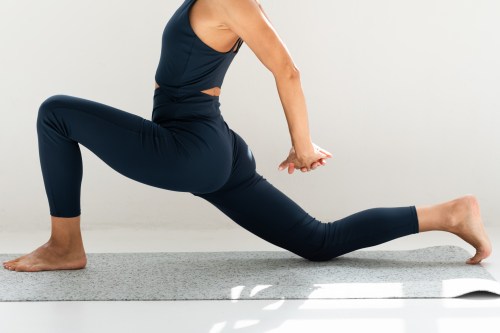It’s time to step into the ring and face off against your greatest opponent—yourself. Shadow boxing workouts let you see just how far you can push your limits by building muscle, improving reflexes, and getting a cardio boost with every punch.
Experts in This Article
NASM-certified personal trainer, coach at Rumble Boxing in NYC, and Nike trainer
“[Shadow boxing] is one of the best workouts dynamically in the sense that you are moving in so many different ways,” says Bobbie Jo Davis, CPT, trainer for Rumble Boxing.
Beyond the physical benefits of shadowboxing, these workouts sharpen your focus and boost your mood, turning each session into a cathartic release.
“The feeling of landing a combo, or throwing a massive power shot, gives you this wave of confidence and tenacity,” Davis says. “Practically everybody in my boxing class leaves smiling and sweaty.”
And you don’t need any special equipment or a partner—just a small space and the willingness to throw punches into the air.
As you master jabs, hooks, and uppercuts, you’ll not only perfect your boxing technique—you’ll unleash a version of yourself that’s mentally tougher and physically stronger. Get ready to sweat, sculpt, and outsmart your biggest challenges!
9 benefits of shadow boxing
1. Supports heart health
Like the rhythmic beating of your heart, each punch in shadow boxing challenges your cardiovascular system. When done consistently, shadow boxing can help strengthen your heart muscle, improve blood pressure and circulation, and reduce the risk of cardiovascular diseases.
And according to a January 2022 study1 in the Journal of Exercise Science and Fitness, activities that involve intense, interval-style training (like shadow boxing) can help improve heart rate variability (HRV), a measure of the heart’s ability to respond to stress and recover from exercise.
2. Provides stress relief
On the days when your to-do list seems unending, you’re butting heads with a coworker, or life just seems overwhelming, it can help to punch it out. The focused nature of punching and moving rhythmically helps divert attention from daily stressors, providing a mental break that helps reduce anxiety and improve overall mood.
“Turning off whatever is bothering you on the outside world and just concentrating on the craft is like a meditation,” Davis says.
According to a 2023 review2 in the American Journal of Lifestyle Medicine, “non-contact boxing provided a cathartic release of anger and stress, with evidence of improved mood, self-esteem, confidence, concentration, metabolic burden, strength and coordination.”
3. Improves mental health
Beyond your day-to-day mood, regularly engaging in shadow boxing sessions offers significant, long-term mental health benefits. In fact, the 2023 review called boxing “a promising intervention to improve mental health burden.”
The combination of physical exertion and the focusing of attention on your body’s movements can help reduce symptoms of depression and anxiety over time.
4. Supports brain health
Just like your heart, your brain relies on adequate blood flow to keep you alert, focused, and thinking clearly. This increased blood flow to the brain during physical activity helps enhance cognitive functions, such as attention and critical thinking.
Specifically, a meta-analysis published in3NeuroImage notes that aerobic exercise, including shadow boxing, can help prevent age-related deterioration in the hippocampus, which is involved in learning and memory.
5. Builds muscular strength and endurance
Punching, by its very nature, involves the muscles of the shoulders, arms, chest, and back. Each punch extends the muscles and then contracts them forcefully, which can lead to increased muscle definition and strength over time.
But perhaps less obvious is the impact it has on your abs. The constant movement of throwing punches requires significant core involvement—particularly your rectus abdominis (“six-pack” muscles) and transverse abdominis (deep ab muscles)—to stabilize your body and generate power. And any side-to-side or twisting motion strengthen the obliques (sides of your torso).
6. Enhances agility and coordination
Shadow boxing is a fast-paced workout that requires precise, rapid movements of both the arms and legs, which trains your mind and body to react quickly and with control. In short, Davis says, it has significant benefits for your hand-eye coordination.
Each punch, duck, and roll improves neuromuscular coordination, improving your ability to execute complex, coordinated movements with greater efficiency. Research published in the Journal of Physical Education and Sports found that the more experience a participant had with boxing, the shorter their reaction time was.
7. Encourages strategic thinking
Even as a solo practice, shadow boxing requires you to visualize an opponent and anticipate their moves. This process of anticipation and reaction not only improves your reflexes but also enhances one’s ability to think strategically under pressure.
“You’re learning patience, diligence, and using breath to help control stress,” Davis says. Each movement and combination must be thought out and executed with precision, mirroring the mental challenges faced in actual sparring or competitive settings.
According to a May 2023 study4 in the European Journal of Investigative Health, Psychology, and Education, cognitively challenging physical activity (like shadow boxing) can improve executive functions like problem-solving and planning.
8. Improves metabolic rate and body composition
“From throwing quick jabs, to power uppercuts, ducking and weaving with defense, boxing is a surefire way to hike up your heart rate,” Davis says. As a HIIT-style workout, shadow boxing increases your metabolic rate and can keep it elevated5 even after the session ends.
That also helps change your muscle mass–body fat ratio. In a January 2015 study6 in BMC Sports Science, Medicine, and Rehabilitation, participants with obesity who did boxing training saw greater reductions in body fat percentage than those whose only exercise was walking.
9. Is accessible and convenient
Need a workout you can do anytime, anywhere? Whether you’re in a cramped apartment, a hotel room, or a park, shadow boxing is an incredibly convenient way to stay active without any special equipment and minimal space. This flexibility makes it easier to incorporate into a busy schedule and removes the barriers often associated with more equipment-heavy workouts.
The ease of lacing up your sneakers (or even going barefoot) and setting aside 10 to 20 minutes can encourage more consistent exercise habits and help you get the 75 to 150 minutes of vigorous-intensity aerobic physical activity recommended in the Physical Activity Guidelines for Americans7.
Songsorn P, Somnarin K, Jaitan S, Kupradit A. The effect of whole-body high-intensity interval training on heart rate variability in insufficiently active adults. J Exerc Sci Fit. 2022;20(1):48-53. doi:10.1016/j.jesf.2021.10.003
↩︎Bozdarov J, Jones BDM, Daskalakis ZJ, Husain MI. Boxing as an Intervention in Mental Health: A Scoping Review. Am J Lifestyle Med. 2022;17(4):589-600. Published 2022 Sep 9. doi:10.1177/15598276221124095
↩︎Firth J, Stubbs B, Vancampfort D, et al. Effect of aerobic exercise on hippocampal volume in humans: A systematic review and meta-analysis. Neuroimage. 2018;166:230-238. doi:10.1016/j.neuroimage.2017.11.007
↩︎Yordanova Y, Pulev T, Kirilova K, Ruteva M, Stambolieva K. Sport experience and visual motor reaction time of boxers. Journal of Physical Education and Sport. 2023;23(5):1176-1181. https://www.proquest.com/scholarly-journals/sport-experience-visual-motor-reaction-time/docview/2837480610/se-2. doi: https://doi.org/10.7752/jpes.2023.05146.
↩︎Kolovelonis A, Goudas M. The Effects of Cognitively Challenging Physical Activity Games versus Health-Related Fitness Activities on Students’ Executive Functions and Situational Interest in Physical Education: A Group-Randomized Controlled Trial. Eur J Investig Health Psychol Educ. 2023;13(5):796-809. Published 2023 Apr 26. doi:10.3390/ejihpe13050060
↩︎Schubert MM, Palumbo E, Seay RF, Spain KK, Clarke HE (2017) Energy compensation after sprint- and high-intensity interval training. PLoS ONE 12(12): e0189590. https://doi.org/10.1371/journal.pone.0189590
↩︎Cheema BS, Davies TB, Stewart M, Papalia S, Atlantis E. The feasibility and effectiveness of high-intensity boxing training versus moderate-intensity brisk walking in adults with abdominal obesity: a pilot study. BMC Sports Sci Med Rehabil. 2015;7:3. Published 2015 Jan 16. doi:10.1186/2052-1847-7-3
↩︎“Physical Activity Guidelines for Americans, 2nd Edition” from the U.S. Department of Health and Human Services
↩︎
Sign Up for Our Daily Newsletter
Get all the latest in wellness, trends, food, fitness, beauty, and more delivered right to your inbox.
Got it, you've been added to our email list.











